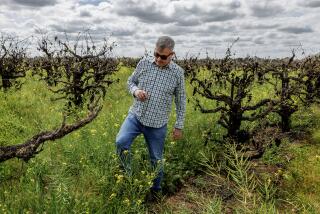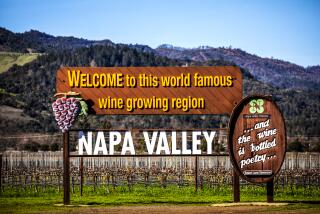Wine dealer accused of fraud that drove up prices worldwide
NEW YORK — Wine expert Michael Egan eyed the six bottles of purported 1966 Montrachet sitting at the front of the courtroom. “They wouldn’t look out of place in the urology department at Mt. Sinai,” Egan said as he noted the cloudy liquid’s sickly ocher cast.
And they probably wouldn’t taste much better than a specimen, according to Egan and other aficionados who testified this week in the fraud trial of Rudy Kurniawan, a onetime boy wonder of the wine world who once enjoyed an enthusiastic following in Los Angeles for his sophisticated palate and eye-popping collection of exquisite reds and whites.
Now Kurniawan, a nebbishy-looking 37-year-old, faces 20 years in prison if convicted on charges he used a laser printer, sealing wax, ink stamps, empty bottles and old corks to perpetuate from his Arcadia home a fraud that wine experts say may have fueled a global surge in fine wine prices.
Jury deliberations begin Wednesday in the trial, whose witnesses included wine authenticators, some of the world’s preeminent French wine producers, and collectors of the most valuable vintages, including billionaire industrialist William I. Koch.
“I got conned,” Koch testified Friday. “I got cheated.” He paid $30,000 in 2005 for what was said to be a double magnum of 1947 Chateau Petrus from the Bordeaux region, a rare wine from a vintage so spectacular that prosecutors say Kurniawan adopted it as a nickname: Mr. 47.
Prosecutors said the bottle was counterfeit and a tiny portion of a massive fraud that played out in auction houses and wine cellars around the world from as early as 2004 until Kurniawan’s arrest in 2012.
In addition to doctoring bottles with fake labels to pass them off as more prized vintages, Kurniawan diluted expensive wines with far cheaper ones and re-corked them to fool buyers, Assistant U.S. Atty. Joseph Facciponti said Tuesday. Prosecutors said he sometimes sold counterfeit bottles alongside genuine rare wines to hide his fraud “so that he could dismiss as spoiled bottles or aberrations” any that were identified as fake.
Wine experts say Kurniawan’s alleged fraud was about more than a few extraordinarily wealthy people being cheated. By acquiring huge amounts of fine wine at auction, he helped fuel competition that boosted prices across the board, they say. From 2002 until 2007, when Kurniawan was at the height of his buying and selling binge — he sold $35 million worth in 2006 alone — the value of fine wine sold worldwide went from $90 million to more than $300 million, Egan testified.
“Every single person who drinks wine was affected by this because it drove all prices up,” said Maureen Downey, a sommelier and wine consultant in San Francisco who came to New York to watch the trial in federal court in Lower Manhattan. “When you raise the ceiling, you raise the floor.”
Throughout the trial, Kurniawan has sat quietly with his defense team, looking small in a gray suit and black-rimmed glasses. His attorney, Jerome Mooney, said Tuesday that Kurniawan was an insecure outsider who loved wine and wanted to be part of the sophisticated world of collectors who drink $5,000 bottles at exclusive tasting dinners.
In his closing statement, Mooney said that Kurniawan, who was born into a wealthy Indonesian family and came to Los Angeles in the 1990s on a student visa, began buying up fine wine in hopes of breaking into that world. He shared his trove with fellow wine-lovers at dinners in lavish restaurants such as Melisse in Santa Monica and Per Se in New York. Often, he picked up the check.
Mooney, who called just one defense witness, said that like all major collectors, Kurniawan sometimes was fooled into buying counterfeit wine. He then unwittingly consigned it to auction houses or sold it privately, Mooney said.
“He’s not educated enough to know the difference” between the real thing and a bottle with a fake label from a fancy vineyard, Mooney said. “He went out there wanting to be part of the club, wanting to show off.”
Mooney said materials found in Kurniawan’s home in a March 2012 raid that prosecutors say constituted a fake wine factory — including thousands of fake wine labels, empty bottles and bags of corks — were evidence merely of Kurniawan’s attempt to recondition old bottles to make them look better.
“He’s cleaning up a few bottles,” Mooney said, comparing it to scrubbing clean a valuable antique.
Kurniawan has said his love of wine began in 2001, when he was at a San Francisco restaurant for his father’s birthday. They bought a 1995 Opus One, a Napa Valley wine that at $150 was the priciest bottle on the wine list. He began acquiring expensive California wines, but soon developed a taste for those from France’s Burgundy and Bordeaux regions. He packed his collection with bottles whose labels virtually guarantee greatness: Domaine de la Romanee-Conti, Domaine Ponsot, Chateau Petrus, Chateau Lafite Rothschild, and others.
Then, prosecutors say, he began counterfeiting the world’s most expensive wines to fund his lavish lifestyle.
“This is a case about greed and lies,” Facciponti said, displaying Kurniawan’s 2007 American Express bill of $6 million, which included $208,908 for clothing at Hermes.
Among the items sought for forfeiture by prosecutors and listed in the criminal indictment are 10 Patek Philippe watches valued at $534,680, a black Lamborghini, a $17,945 Mont Blanc pen and Kurniawan’s homes in Arcadia and Bel-Air.
As Kurniawan’s wine collection grew, so did suspicion about the young collector and his habits.
Witnesses testified that he was obsessed with reclaiming empty bottles from tasting dinners and that he bought hundreds of bottles of unimpressive wine that no serious collector would want — wine that prosecutors say was used in his “witch’s brew” of fake fine wine.
One witness, wine collector Douglas Barzelay, testified that he became suspicious in 2008 when he viewed an auction catalog that included bottles from Kurniawan’s cellar, purported to be Domaine Ponsot wines from as far back as 1945.
“I wasn’t even aware they existed,” Barzelay said.
He alerted Laurent Ponsot in France, who confirmed they did not. The wine in question was first produced in 1982, Ponsot testified in court.
The wines were pulled from the auction.
In addition to the suspected wine fraud, prosecutors say Kurniawan also lied on a loan application about his immigration status by saying he had applied for permanent residence, even though he was denied asylum in 2003 and ordered to leave the country.
Mooney said Kurniawan never learned of the ruling because it was sent to the wrong address.
More to Read
Sign up for Essential California
The most important California stories and recommendations in your inbox every morning.
You may occasionally receive promotional content from the Los Angeles Times.











